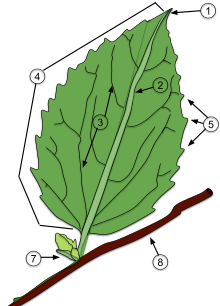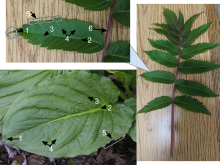**Leaf Structure and Function:**
– Leaves are essential for most vascular plants as they carry out photosynthesis and transpiration.
– The primary photosynthetic tissue in most leaves is the palisade mesophyll.
– Leaves have distinct upper and lower surfaces with different features, and chlorophyll gives leaves their green color.
– Leaf morphology includes petioles, lamina, stipules, and sheaths, aiding in plant identification.
– Leaves transport sugars through phloem and water through xylem and store chemical energy and water.
**Leaf Diversity and Evolution:**
– Leaves come in various shapes, sizes, textures, and colors, with adaptations to climate and light.
– Early leaves evolved as extensions of the stem, with true leaves emerging later in various plant lineages.
– Euphylls or macrophylls are large leaves found in later plant groups, and the evolution of leaves coincided with atmospheric changes.
– Leaf types can be monomorphic, dimorphic, or polymorphic, and some plants retain leaves for long periods.
– The leaf diversity includes broad, flat megaphylls, simple microphylls, and succulent leaves.
**Leaf Arrangement and Venation:**
– Phyllotaxis refers to the arrangement of leaves on the stem, with patterns like alternate, opposite, and whorled.
– Leaf veins represent the vascular structure, transporting water, nutrients, and providing mechanical support.
– Vein patterns include single veins dividing into parallel or reticulate patterns, with primary and secondary veins.
– Different rotation fractions determine leaf arrangements around the stem, and Fibonacci numbers are often related to phyllotaxis sequences.
– Monocots typically have parallel venation, while eudicots and magnoliids have reticulate venation.
**Leaf Morphology and Types:**
– Leaf morphology terminology includes characteristics like shape, margin, and presence of glands for plant identification.
– Basic leaf types include deciduous and evergreen, petiolate and sessile, needle-shaped in conifers, and fronds in ferns.
– Compound leaves can be palmately or pinnately divided, with bifoliolate leaves having only two leaflets.
– Leaf structures consist of petioles, lamina, sheaths, and stipules, with variations in the presence of certain components.
– Leaf types can be simple with an undivided blade or compound with fully subdivided blades.
**Leaf Vein Structure and Evolution:**
– Veins in leaves play a crucial role in leaf water status, photosynthesis, and providing support.
– Major veins transport photosynthate out of the leaf, while minor veins facilitate exchange between mesophyll and vascular system.
– Vein hierarchy appeared in the Triassic, enabling larger leaf sizes and climatic adaptations.
– Evolution of vein hierarchy allowed for adaptions to diverse climates, with branching veins considered plesiomorphic.
– Venation patterns evolved over time, with dichotomous branching in early taxa and pseudo-reticulate venation in ancient seed plants.
A leaf (pl.: leaves) is a principal appendage of the stem of a vascular plant, usually borne laterally aboveground and specialized for photosynthesis. Leaves are collectively called foliage, as in "autumn foliage", while the leaves, stem, flower, and fruit collectively form the shoot system. In most leaves, the primary photosynthetic tissue is the palisade mesophyll and is located on the upper side of the blade or lamina of the leaf but in some species, including the mature foliage of Eucalyptus, palisade mesophyll is present on both sides and the leaves are said to be isobilateral. Most leaves are flattened and have distinct upper (adaxial) and lower (abaxial) surfaces that differ in color, hairiness, the number of stomata (pores that intake and output gases), the amount and structure of epicuticular wax and other features. Leaves are mostly green in color due to the presence of a compound called chlorophyll which is essential for photosynthesis as it absorbs light energy from the sun. A leaf with lighter-colored or white patches or edges is called a variegated leaf.



- Apex
- Midvein (Primary vein)
- Secondary vein.
- Lamina.
- Leaf margin
- Petiole
- Bud
- Stem

Bottom: skunk cabbage, Symplocarpus foetidus (simple leaf)
- Apex
- Primary vein
- Secondary vein
- Lamina
- Leaf margin
- Rachis
Leaves can have many different shapes, sizes, textures and colors. The broad, flat leaves with complex venation of flowering plants are known as megaphylls and the species that bear them, the majority, as broad-leaved or megaphyllous plants, which also include acrogymnosperms and ferns. In the lycopods, with different evolutionary origins, the leaves are simple (with only a single vein) and are known as microphylls. Some leaves, such as bulb scales, are not above ground. In many aquatic species, the leaves are submerged in water. Succulent plants often have thick juicy leaves, but some leaves are without major photosynthetic function and may be dead at maturity, as in some cataphylls and spines. Furthermore, several kinds of leaf-like structures found in vascular plants are not totally homologous with them. Examples include flattened plant stems called phylloclades and cladodes, and flattened leaf stems called phyllodes which differ from leaves both in their structure and origin. Some structures of non-vascular plants look and function much like leaves. Examples include the phyllids of mosses and liverworts.
